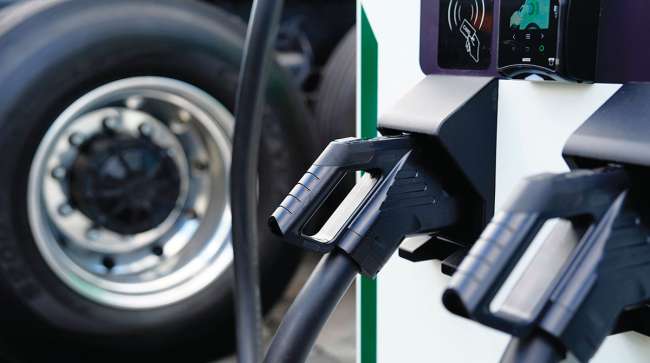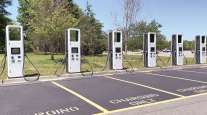Staff Reporter
EPA Grants 4 States $248.9M for I-95 EV Truck Charging Sites

[Stay on top of transportation news: Get TTNews in your inbox.]
The U.S. Environmental Protection Agency is paying $248.9 million to develop 24 electric truck charging sites for medium- and heavy-duty vehicles along the Interstate 95 freight corridor in four East Coast states.
The grant recipients were notified by EPA in July, and the award was celebrated Oct. 23.
Lisa Garcia, EPA administrator for Region 2, called the federal grant “a pivotal investment” to lower emissions “along one of the nation’s busiest freight corridors, create jobs, and deliver health benefits to communities along this key transportation route.”
The corridor was selected for its large population centers, major ports and key freight facilities. The federal government has targeted areas within a 100-mile radius of the nation’s largest ports as initial priority zones for transportation decarbonization, due to their surrounding freight ecosystems. The I-95 corridor handles much of the freight from 15 of the nation’s largest ports.

The funding will create EV charging infrastructure along I-95 in Connecticut, Delaware, Maryland and New Jersey. The 24 sites will offer three charging options: 138 ultra-fast charging ports (1 megawatt), 164 fast-charging ports (350 kilowatt) and 148 overnight ports (150 kW).
The U.S. Department of Energy defines direct current fast-charging equipment as providing 100 to 200 miles of range per 30 minutes of charging time. The department has not provided specifications for ultra-fast charging.
The EPA grant comes from its Climate Pollution Reduction Grant program, which awards about $5 billion annually to states, local governments, tribes and territories to develop and implement plans to reduce air pollution, including greenhouse gas emissions. The Clean Corridor Coalition, led by the New Jersey Department of Environmental Protection, received the grant. Other coalition members include the Connecticut Department of Energy and Environmental Protection, Delaware Department of Transportation, and Maryland’s DOT and Department of the Environment.
Through a $250 million EPA grant, 24 freight truck charging sites will be built along the I-95 corridor in four states, including NJ. Officials say it is expected to reduce greenhouse gas emissions by 18.6 million metric tons of CO2 equivalent by 2050. https://t.co/g0cjwlORd5 — NJ Spotlight News (@NJSpotlightNews) October 25, 2024
“Expanding our charging infrastructure for medium- and heavy-duty vehicles is key to lowering emissions and improving air quality in our communities,” said New Jersey Gov. Phil Murphy. “I’m proud to celebrate building out charging infrastructure along the I-95 corridor, which will help us facilitate New Jersey’s transition to an electric vehicle future, support workforce development, and provide benefits to our overburdened communities.”
The grant also aims to develop and train 400 workers in the construction, operation and maintenance of heavy-duty EV infrastructure.

Murphy
The coalition’s EPA request predicted that public charging stations for commercial medium- and heavy-duty EVs can reduce near-term emissions and provide market certainty for fleet operators and freight stakeholders to invest in EVs.
“These [new EPA-funded] charging stations will also accelerate deployment of zero-emission regional and longhaul freight operations,” the coalition stated.
The states indicated that “$100 [billion]-$166 billion in investment must be committed nationally before 2030, with $65 [billion]-$135 billion for on-road MHD [medium- and heavy-duty] EV charging alone, to support the pathway toward 100% electric MHDV new sales by 2040.”
Truck drivers will need significant public charging capacity and electric power along the I-95 freight corridor between Connecticut and Maryland.
McLeod Software CEO Tom McLeod explores the potential for artificial intelligence to boost efficiency and build resilience. Tune in above or by going to RoadSigns.ttnews.com.
“Of the 30 U.S. counties with the highest projected charging demand per unit area, five are along the I-95 corridor in New Jersey, indicating the critical need to deploy charging infrastructure along this corridor,” the coalition added.
The New Jersey Department of Environmental Protection plans to issue a purchase order for a third-party grant administrator in January. Site selection and project design requirements will occur from January through October 2025, including public input from charging site hosts and truck owners.
The states will solicit proposals for charging stations from January through March 2026, with developer agreements to be signed by December 2026. Funding disbursement will occur from 2027 to 2029, followed by a second round of proposals and funding through December 2029. The timeline doesn’t specify when stations will begin operating.
“Electric vehicles are the future, and our infrastructure investments must reflect that,” said U.S. Rep. Donald Norcross (D-N.J.). “The $250 million New Jersey will be receiving for I-95 is an important step in the right direction toward combating climate change and will help us cut down on carbon emissions.”
EPA says the project will reduce emissions by 18.6 million metric tons by 2050 and provide a successful prototype for deployment in other areas of the nation.
Want more news? Listen to today's daily briefing below or go here for more info:





